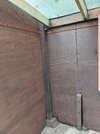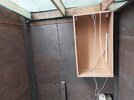It is a standard loft floor, made of 225x50 joists spanning from 2.8m to 4.5m, in between walls and steel beams. We have placed the joists 400mm apart at the shorter lengths and 350mm apart at the longer lengths. The area is about 250m2.
We have used "structural hardwood" 18mm plywood.
We laid the first two areas today the carpenter used only screws on every section, no foam or other glue.
The partition walls have been set out first, so in theory, in the future we will be able to lift a board by just taking out the screws (excluding skirting boards etc).
Between the 3 available materials, chipboard, "structural OSB 3" and structural ply, the ply and then the OSB are the more robust. In cases of extreme conditions, eg laid on the ground, in rain and with lorries and a forklift driving over, the plywood is by far superior. There are about 60 structural OSB boards upstairs used as temporary flooring, for about a year, exposed to rain and sun for about 8 months, some look to be in good shape, some are coming apart. I would not use either ply or OSB that's been in the rain for months, but the ply is still together structurally whereas the OSB cracks and pieces are coming off.
Some people have warned me that some plywood manufacturers use low quality glues and they delaminate with time. My most recent batch came from China. I hope they used good quality glues to make them!



